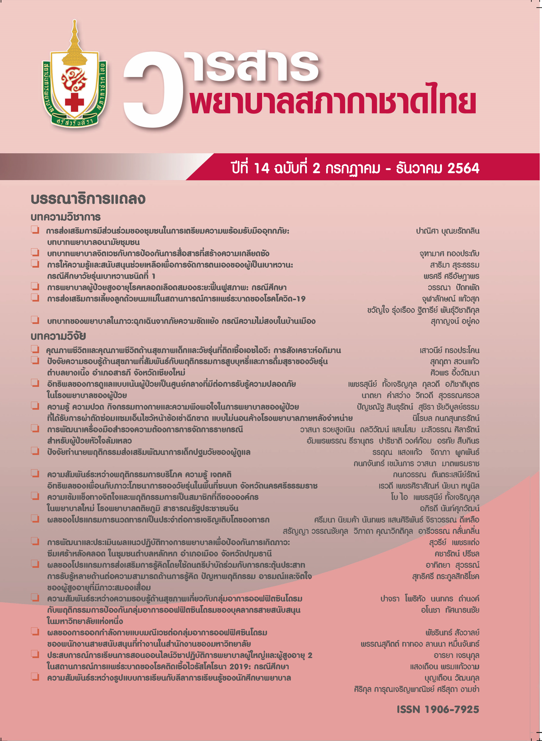The Effects of a Regular Infant Massage Program on Infant Growth
Keywords:
infant massage, massage program, regular massage, infant growthAbstract
Infant massage is an activity that can help enhance growth and development of an infant who is experiencing a period of rapid growth. The purpose of this intervention study was to determine the effects of infant growth following a massage program which was performed on a regular basis for a duration of 8 weeks. The samples consisted of 48 pairs of mother-infant dyads at a well-baby clinic which were then divided into a control and an experimental group with 24 pairs in each group. The research instruments used within the study consisted of data collection forms, a weight scale, a baby length measuring board, a head circumference measuring tape, and an infant massage program. Data were analyzed with the statistical use of descriptive statistics, independent t-test, Chi-square test, and Gaussian regression.
The findings of this study indicated that after 4 weeks of having the mothers massage their infants and completing the infant massaging program, the participants in the experimental group had a significant higher mean of occipito-frontal circumference and body weight than those in the control group (p < .01), but the length was not found to be significantly different. Moreover, after 8 weeks of completing the infant massaging program, the experimental group demonstrated a significant higher mean of occipito-frontal circumference and body weight than those in the control group (p < .05 and p < .01, respectively), while the length remained statistically insignificant. The results suggest that the regular infant massage program promote infant physical growth as assessed by the parameters indicating an increase in growth in the head circumference and total body weight. The results further encourage mothers to continue infant massaging on a daily basis.
References
Bennett C, Underdown A, Barlow J. Massage for promoting mental and physical health in typically developing infants under the age of six months. Cochrane Database Syst Rev 2013; 2013(4):CD005038.
Badr LK, Abdallah B, Kahale L. A meta-analysis of preterm infant massage: an ancient practice with contemporary applications. MCN Am J Matern Child Nurs 2015;40(6):344-58. doi: 10.1097/NMC.0000000000000177.
Pados BF, McGlothen-Bell, K. Benefits of Infant massage for infants and parents in the NICU. Nurs Womens Health 2019;23(3):265–71. doi: 10.1016/j.nwh.2019.03.004.
Field T, Diego M, Hernandez-Reif M, Dieter JNI, Kumar AM, Schanberg S, et al. Insulin and insulin-like growth factor-1 increased in preterm neonates following massage therapy. J Dev Behav Pediatr 2008;29(6):463-6. doi: 10.1097/DBP.0b013e3181856d3b.
Yakar S, Werner H, Rosen CJ. Insulin-like growth factors: actions on the skeleton. J Mol Endocrinol 2008;61(1):T115–37. doi: 10.1530/JME-17-0298.
Field T, Diego M, Harnandez-Reif M. Preterm infant massage therapy research: a review. Infant Behav Dev 2010;33(2):115-24. doi: 10.1016/j.infbeh.2009.12.004.
Field T. Preterm infant massage therapy studies: an American approach. Semin Neonatol 2002;7(6):487-94.
Narenji F, Rosbahany N. The effects of massage therapy on weight gain and sleep behaviors in infants. Koomesh 2008;9(4):279-84.
Yılmaz HB, Conk Z. The effect of massage by mothers on growth in healthy full-term infants. International Journal of Human Sciences 2009;6(1):969-77.
Cooke A. Infant massage: the practice and evidence-base to support it. Br J Midwifery 2015;23(3):166-70.
Burns N, Grove SK. The practice of nursing research: conduct, critique and utilization. 5th ed. St Louis: Saunders Elsevier; 2005.
Polit D, Hungler B. Nursing research: principle and method. 6th ed. Philadelphia: Lippincott; 1999.
Field T, Diego M, Hernandez-Reif M. Potential underlying mechanisms for greater weight gain in massaged preterm infants. Infant Behav Dev 2011;34(3):383-9. doi: 10.1016/j.infbeh.2010.12.001.
Schulzke SM, Kaempfen S, Trachsel D, Patole SK. Physical activity programs for promoting bone mineralization and growth in preterm infants. Cochrane Database Syst Rev 2014; 4:CD005387. doi: 10.1002/14651858.CD005387.pub3.
Lee HK. The effects of infant massage on weight, height, and mother-infant interaction. J Korean Acad Nurs 2006;36(8):1331-9.
Karbasi SA, Golestan M, Fallah R, Golshan M, Dehghan Z. Effect of body massage on increase of low birth weight neonate’s growth parameters: a randomized clinical trial. Iran J Reprod Med 2013;11(7):583-8.
Kumar J, Upadhyay A, Dwivedi AK, Gothwal S, Jaiswal V, Aggarwal S. Effect of oil massage on growth in preterm neonates less than 1800 g: a randomized control trial. Indian J Pediatr 2013; 80:465-9. doi: 10.1007/s12098-012-0869-7.
Ekbote VH, Khadilkar VV, Khadilkar AV, Mughal Z, Chiplonkar SA, Palande SA, et al. Relationship of insulin-like growth factor 1 and bone parameters in 7–15 years old apparently, healthy Indian children. Indian J Endocrinol Metab 2015;19(6):770-4. doi: 10.4103/2230-8210.167549.
Kelmansao IA, Adulas EI. Massage therapy and sleep behaviour in infants born with low birth weight. Complement Ther Clin Pract 2006;12(3):200-5. doi: 10.1016/j.ctcp.2005.11.007.
Diego MA, Field T, Hernandez-Rief M. Preterm infant weight gain is increased by massage therapy and exercise via different underlying mechanisms. Early Hum Dev 2014;90(3):137-40. doi: 10.1016/j.earlhumdev.2014.01.009.
Kulkarni A, Kaushik JS, Gupta P, Sharma H, Agrawal RK. Massage and touch therapy in neonates: The current evidence. Indian Pediatr 2010;47(17):771-6.
Downloads
Published
Issue
Section
License

This work is licensed under a Creative Commons Attribution-NonCommercial-NoDerivatives 4.0 International License.
เนื้อหาบทความหรือข้อคิดเห็นต่างๆ ในวารสารพยาบาลสภากาชาดไทยนี้ เป็นความคิดเห็นของผู้เขียนบทความ ไม่ใช่ความเห็นของกองบรรณาธิการ หรือสถาบันการพยาบาลศรีสวรินทิรา สภากาชาดไทย






